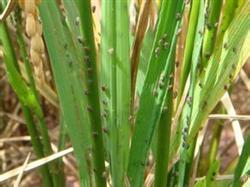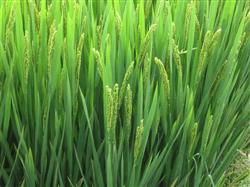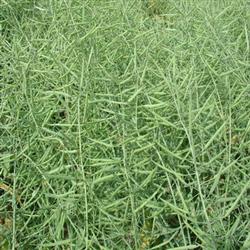Rice brown planthopper

Rice brown planthopper is also known as brown planthopper, commonly known as Ascaris lumbricoides, soft shell Ascaris, Ascaris, midges. Scientific name Nilaparvata lugens (Stdl) Homoptera, Homoptera. Brown planthopper (Nilaparvata lugens) is one of the main rice pests in China, which occurs in all the major rice regions in the north and south of China, and occurs with white-backed planthoppers every year. The two kinds of planthoppers occur to different degrees in different provinces and regions in different years, and the annual damage area is more than 200 million mu. Brown planthopper (Nilaparvata lugens) has a single feeding habit, only to harm rice and common wild rice. The nymphs gather in the lower part of the rice clump to suck juice, and the female uses the ovipositor to pierce the leaf sheath and leaves to lay eggs, which is easy to make the rice plant dehydrated or infected with Sclerotinia sclerotiorum. Excreta is often caused by mildew, which affects the photosynthesis and respiration of rice, and serious rice plants are withered. Commonly known as "presumptuous piercing", "through the top" or "collapse". When it is serious, there is no harvest. The morphological characteristics of adults can be divided into two types: long-wing type and short-wing type. The long-winged body is 4-5mm long, yellowish brown and dark brown, with oily luster, three protruding longitudinal ridges on the face, the middle ridge uninterrupted, the female's abdomen is longer and the end is conical, the male's abdomen is short and thin, and the end is similar to the horn tube. The short-winged adults have short wings, while the others are similar to long-winged adults. The egg cap is exposed, with 2-3 to 20 eggs as an egg mass; in the egg mass, the eggs are arranged in a single row at the front and squeezed into two rows at the back end, and the eggs are slender and slightly curved. The nymph has five ages and is similar to an adult in shape. 1-year-old grayish white, 2-year-old yellowish brown, no winged buds, straight posterior margin of the chest, a light thick "T"-shaped pattern in the center of the back of the abdomen, brown to dark brown in the 3-year-old, wing buds appeared, and a pair of triangular markings of white wax powder appeared on the back of the third section, like 2 white horizontal lines. At the age of 4-5, the body markings were similar to those of the 3rd instar, but the body shape increased and the markings were more obvious. the difference from the short-winged adults was that the short-winged left and right wings were close to the left and right wings, the wing ends were round, the wing spots were obvious, and there were no white horizontal stripes on the abdomen and back. The occurrence regularity is 12-13 generations a year in Hainan, and generations overlap and reproduce all the year round, without overwintering phenomenon. Guangdong, Guangxi and southern Fujian emigrated from March to May, 6-7 generations from southern Guizhou, 5-6 generations from May to June in the middle and lower reaches of Ganjiang River, Guizhou, central and northern Fujian and southern Zhejiang, 4-5 generations from northern Jiangxi, Hubei, Hunan, Zhejiang, southeastern Sichuan, Jiangsu and southern Anhui, and from June to mid-July. The 2-3 generations of northern Jiangsu, northern Anhui and southern Shandong moved in from July to August, and the other rice areas in the north also moved in from July to August. The main pest sources in the vast rice areas of China move in and advance from south to north with the annual damage and warm and humid air flow in summer, there are about five large migrations every year, and the team moves back from north to south in autumn. The egg duration below 17 ℃ is more than 17 days, 23-24 ℃ 9 days, 27-30 ℃ 7-8 days. The duration of 24-26 ℃ of nymphs is 15-16 days. The short-winged adult belongs to the resident type and the long-winged type belongs to the migratory type. Soon after Eclosion, the flying ability is strong, and it can migrate with the upper horizontal airflow. When it moves northward in spring and summer, the flight altitude is 1500-2000m, the air humidity is high, and the initial flight temperature is about 18.2m. The adult has an obvious tendency to tender green rice, and the male can mate many times. At 24-27 ℃, mating begins 2-3 days after Eclosion, with an average of 200-700eggs per female. The average life span of each generation during the growth period of rice is 10-18 days, and the multiplication multiple in the field is 10-40 times. Adults and nymphs prefer overcast and wet environment and like to live on rice plants within 10cm from the surface of the water. When the population of each clump in the field is higher than 0-4, there is uneven distribution, and the phenomenon of collapse and death occurs in the field in the later stage. In the later stage of rice growth, a large number of long-winged adults were produced and moved out, and the 1-3 instar was the key period of wing differentiation. In recent years, due to the change of farming system in various rice regions of China, the rice varieties are very complex and the growth periods are staggered, which is conducive to the increase of the insect population and cause serious damage. The suitable temperature for the growth and development of the insect is 20-30 ℃, and the optimum temperature is 26 ℃. It is not hot in summer in the Yangtze River basin, and the temperature is high in late autumn. When the brown planthopper moves in, it is easy to occur when it moves in, the field is shady and wet, the rice seedlings are thick green, the density is high and the deep water is irrigated for a long time, and the damage is serious. The natural enemies are rice lice tassel wasp, brown waist Trichogramma, planthopper red chelate wasp, rice lice nematode, black shoulder green bug and so on. Control methods (1) breeding and popularizing insect-resistant and high-yielding varieties to prevent the emergence of new biotypes of brown planthopper. For example, Chinese hybrid rice Shanyou 6 was lightly injured in the area of brown planthopper biotype I. In addition, insect-resistant varieties such as Xiangzaogao No. 1 and No. 3, Guangyouqing, Qiguizao 25, Weiyou 35, Ⅱ you 46, D you 64, Weiyou 64, Nanjing 14, Yangdao 3, Shuiyuan 290 and Xiushui 620 can be selected according to local conditions. (2) strengthen the management of fertilizer and water in the field. Properly roast the field, reduce the field humidity, avoid partial application of nitrogen fertilizer, prevent rice from greedy and overgrowing in the later stage, and create ecological conditions that are not conducive to the breeding and breeding of brown planthopper. (3) protect and utilize natural enemies. There are many kinds of parasitic and predatory natural enemies in each stage of brown planthopper. In addition to parasitoids, black-shouldered green bug bugs and ladybugs, spiders, nematodes and fungi can greatly inhibit the occurrence of brown planthopper, which should be protected and utilized to improve the ability of natural control. (4) do a good job in measuring and forecasting, do a good job in the analysis of migration trend, unified planning during planting, rational layout, and reduce the source of insects. (5) Pesticide control. According to the type of rice varieties and the occurrence of planthoppers, the strategy of pre-control and post-control or ruthless control of the main damage generation was adopted. during the period from the peak of nymph hatching to the peak of 2-3 instar nymphs, 2.5% aphid wettable powder or 25% buprofezin wettable powder was sprayed in time, 20-30g per 667m2 in early rice, early and middle rice and late rice fields, 50g in late rice fields, or 50-100mL in 10% Dolabao suspension. You can also use 2000 times of 667m2 (imidacloprid) wettable powder (10-20g water-to-water 60kg). The control effect is more than 90% in 1-30 days and lasts for 30 days. In addition, the early control effect of 80% insecticidal single powder 35-40g is better than that of leafhopper powder, and it can also control other pests. It is recommended to use 20% Kangfu doxorol solvent per 667m2 6-8mL or 40% Miankang bell EC 30-40 g 10% wettable powder, 2 g active ingredient per 667m2 to control rice planthopper, leafhopper and thrips. 650g/hm2 can also be used to control planthopper, Chilo suppressalis, Chilo suppressalis, Chilo suppressalis and Chilo suppressalis. Commonly used medicament great hero, diazinon, lice aphid, buprofezin, Dolabao, imidacloprid, insecticidal single, Miankang bell, lice borer, buprofezin.
- Prev

Strengthening the Prevention and Control of Diseases and insect pests in the Middle and later stage of Rice
At present, it is the booting stage of rice. in order to conscientiously do a good job in the prevention and control of diseases and insect pests in the middle and later stages of rice and ensure the increase of rice production and income this year, Shuangfengqiao Street has recently taken effective measures to strengthen the prevention and control of diseases and insect pests in the middle and later stages of rice. Because last winter this spring is a warm winter year, rice stem borer, rice leaf roller, rice planthopper.
- Next

How to fertilize rape in winter
Rape is "flowering but unfruitful", also known as shrinking unfruitful. That is, from the onset of the plant to maturity, it still blossoms one after another, but it can not bear fruit normally. It is a physiological disease caused by planting rape in boron-deficient soil, which mainly occurs in Brassica napus varieties, but it has also been found in Brassica napus in recent years. After the attack.
Related
- The first cup of black tea in spring, the flavor and history of tea gardens in Kenya, Africa
- The computer can not only choose potatoes, but also grow tea rice. AI will grow winter oolong tea champion.
- It is not only the inflated tea bitten by insects, but also engraved with the four seasons tea in Beipu.
- The Oriental Beauty Tea Festival in Zhuxian County takes the stage at the weekend to experience the plus-size feast of oil tea.
- & quot; Oriental Beauty Tea & Exploration of Emei in Hsinchu, the hometown of quot;
- The new variety of strawberry "Tainong 1" dessert is the first choice with mellow aroma. Crimson gorgeous
- History of Tea in Taiwan: from Wild Inner Mountain to Export Tea Garden
- Two types of Taiwan Oriental Beauty Black Tea won the British three-Star Award for Childhood Tea Xiang Zhang Jiaqi changed from pilot to champion tea maker.
- Banana species and varieties: the planting history of Taiwan Xianren banana and dwarf banana is long, is banana disease resistant?
- Coffee planting Technology: Qianjie Coffee from Seedling to harvesting

